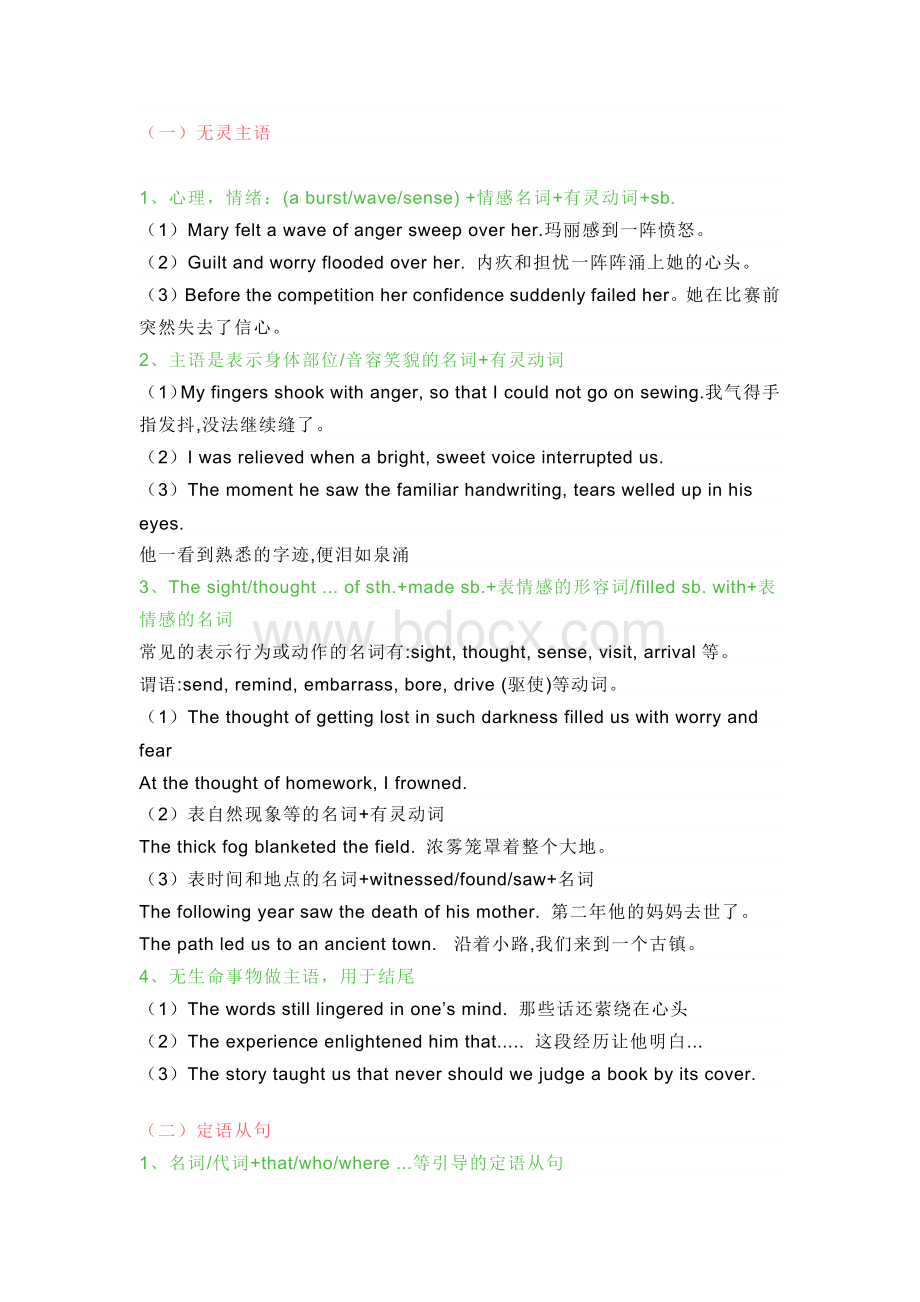高中英语考试读后续写高分句型.docx
《高中英语考试读后续写高分句型.docx》由会员分享,可在线阅读,更多相关《高中英语考试读后续写高分句型.docx(8页珍藏版)》请在冰豆网上搜索。

(一)无灵主语
1、心理,情绪:
(aburst/wave/sense)+情感名词+有灵动词+sb.
(1)Maryfeltawaveofangersweepoverher.玛丽感到一阵愤怒。
(2)Guiltandworryfloodedoverher.内疚和担忧一阵阵涌上她的心头。
(3)Beforethecompetitionherconfidencesuddenlyfailedher。
她在比赛前突然失去了信心。
2、主语是表示身体部位/音容笑貌的名词+有灵动词
(1)Myfingersshookwithanger,sothatIcouldnotgoonsewing.我气得手指发抖,没法继续缝了。
(2)Iwasrelievedwhenabright,sweetvoiceinterruptedus.
(3)Themomenthesawthefamiliarhandwriting,tearswelledupinhiseyes.
他一看到熟悉的字迹,便泪如泉涌
3、Thesight/thought...ofsth.+madesb.+表情感的形容词/filledsb.with+表情感的名词
常见的表示行为或动作的名词有:
sight,thought,sense,visit,arrival等。
谓语:
send,remind,embarrass,bore,drive(驱使)等动词。
(1)Thethoughtofgettinglostinsuchdarknessfilleduswithworryandfear
Atthethoughtofhomework,Ifrowned.
(2)表自然现象等的名词+有灵动词
Thethickfogblanketedthefield.浓雾笼罩着整个大地。
(3)表时间和地点的名词+witnessed/found/saw+名词
Thefollowingyearsawthedeathofhismother.第二年他的妈妈去世了。
Thepathledustoanancienttown. 沿着小路,我们来到一个古镇。
4、无生命事物做主语,用于结尾
(1)Thewordsstilllingeredinone’smind.那些话还萦绕在心头
(2)Theexperienceenlightenedhimthat.....这段经历让他明白...
(3)Thestorytaughtusthatnevershouldwejudgeabookbyitscover.
(二)定语从句
1、名词/代词+that/who/where...等引导的定语从句
名词/代词指物时,用that/which,指人时用that/who/whom,
指地点/时间时,从句中缺状语,分别用where,when,名词是reason,从句中缺状语用why。
(1)Hetookherdowntoaroomwheretherewerebooksandpictures.
(2)Shelookedatthepresentsforhermotherwhichwereinabasketunderachair.
2、名词/代词,which/who/where/as...等引导的非限制性定语从句
主句与从句用逗号隔开。
which可译为“这一点”,as引导该句式意为“正如”。
(1)Hannah,whohadbroughtwood,madeafire.汉娜带来了木柴,燃起了炉火。
(2)Hekeptaperfectlycalmtone,whichcalmedmedown他的语气非常平静,这使我平静下来。
3、主句,whose+表身体部位的名词+谓语动词whose+n.作定语
(1)Thetwinsgazedattheirmother,whoseeyeswerefilledwithtearsofjoy.
(三)状语从句
1、形容词(短语),主+谓……表达人物做某动作的原因、结果或状态,可放在句首或句末,增强感染力。
(1)Exhausted,hefloppeddownintoachair.他筋疲力尽,一屁股坐到椅子上。
(2)Eagertoseeherbeloveddaughter,thewomanquickenedherpacetowardsthebuilding.(因为)急于见到她心爱的女儿,这位妇女加快步伐向那座建筑物走去。
2、as/though引导的让步状语从句
(1)Hardasheworked,hestillcouldn'tcatchupwiththerestoftheclass.
尽管他很努力,但他仍然赶不上班上的其他同学。
(2)Braveasheappeared,hewasactuallytremblingwithfearinside.
尽管他看起来很勇敢,但内心实际上在因害怕而颤抖。
(四)非谓语
1、V-ing,主句或者主句,V-ing.(两动作同时发生)
Shoutingforhelp,herantowardsthenearesthouse.他大声呼救着,跑向最近的房子。
Feelingecstatic,shedashedoutoftheroomlikeawind.她(感到)欣喜若狂,像风一样冲出了房间。
Heranacrossthefinishline,grinningwithprideandjoy.
他跑过终点线时,骄傲和喜悦的笑容洋溢在脸上。
2、Havingdonesth,主句.(两动作先后发生)
(1)Havingwavedgoodbye,sheturnedandwalkedaway.
挥手告别后,她转身离去。
(2)Havingfinishedthework,hefeltagreatsenseofachievement.
完成这项工作后,他感到了一种巨大的成就感。
3、V-ed,主句,V-ing.(情绪形容词+2个动作)
Relievedandoverjoyed,weyelledatthehelicopter,tryingtocatchitsattention.
我们松了一口气,欣喜若狂,对直升机大喊大叫,试图引起它的注意。
Regretfulandembarrassed.Iadmittedthelackofconsideration,longingforanotherchancetomakeitup.遗憾和尴尬,我承认缺乏考虑,渴望再有一次机会来弥补。
(五)独立主格结构
1、逻辑主语+非谓语(ing/ed/todo),主句.
(With)tearswellingupinhiseyes,hethankedthepoliceinatremblingvoice.
(With)Witheverythingwellprepared,theycarriedthebreakfastupstairs.
(With)Withloadsofhomeworktodo,Ihadnooptionbuttodealwithit.
2、独立主格-常用肢体语言:
Eyesfilledwithtears,sbdidsth.(眼里被泪水填满,某人做某事)
Faceblushingscarlet,heapologizedforwhathehadlone.(羞愧脸红,道歉)
Herheartburningwithfrustration,shedidsth.(内心因沮丧而燃烧煎熬,她...)
(六)巧用with复合结构
1、with+情感名词/withone'seyesfullof/filledwith+(tearsof+)情感名词,主+谓
如withdelight/anger/terror“高兴地/生气地/惊恐地”等或withone’seyesfullof/filledwithhappiness“双眸里满是喜悦”等作伴随状语,可使描写更生动。
(1)Mrs.Fairfaxannouncedwithgreatexcitementthatshewasplanningahouse-party.
(2)Hefroze,withhiseyesfullofhorror.他呆住了,眼里满是恐惧。
2、with+sth.+doing/done/todo+主+谓该结构表原因、结果或伴随状态。
如withawaveofexcitementwellingupinsideher“一阵激动涌上心头”。
(1)Hestoodsilently,withtearsrollingdownhischeeks.
他静静地站着,眼泪流下他的脸颊。
(2)Withherplanruined,sheletout/utteredacryofanger
她的计划被毁,她愤怒地大叫一声。
3、with+(形容词)+身体部位的名词+主+谓
如withherpalelips“用她苍白的嘴唇”,withhertremblinghand“用她颤抖的手”等。
(1)Heopenedthedoorwithashakinghand.他用颤抖的手打开了门。
(七)名词性从句添亮点
1、主语从句
(1)That/Whether/Wh-等引导的主语从句+谓语
Whatinterestedusmostwerethreecrossesinredink.我们最感兴趣的是用红墨水画的三个叉。
(2)it形式主语的主语从句:
itbe+adj.(clear/obvious...)+that从句
Itwasobviousthatshecoulddonothingbutwait.
2、宾语从句
(1)主语+谓语+that/what/whether...+宾语从句
从句作宾语,位于及物动词、动词短语、形容词或介词(短语)之后,如表“是否”用if/whether引导。
JodiscoveredthatLaurielovedbooksasmuchasshedid.琼发现罗瑞和她一样爱书。
3、表语从句
(1)主语+系动词+that/what/when...+表语从句
itseems/looksasif/though“看似……”。
Thefactisthatasmallsmilemaymakeabigdifference.事实是一个小小的微笑可能会有很大的不同。
4、同位语从句
(1)名词+that/whether/wh-等引导的同位语从句
该句式中的名词通常是表事实的抽象名词,如fact,hope,idea,news,thought,advice,doubt等。
IreceivedamessagethatIwaswantedinthecabin.我收到消息,说船舱那需要我过去。
5、表“某人想到……”的句式,比sb.thought+that从句更高级。
(1)idea,thought...+hit/struck/occurredto/dawnedonsb.
也可用it作形式主语:
构成Itsuddenlyhit/struck/occurredto/dawnedonsb.that...
Thenitstruck/hit/occurredtoArthurthatitwashethatcouldsolvetheproblematthatmoment.
然后亚瑟想到那时就是他可以解决这个问题。
(2)sth.crossed/flashedthrough/cameto/poppedintosb.’smind
该句式也可用it作形式主语:
Itcrossed/flashedthrough/cameto/poppedintosb.’smindthat...。
Thethoughtcrossedhermindthatshehadleftthedooropen.她突然想起她没关门。
(3)one’smindbegantorace/one’smindraced某人开始转动脑筋/某人拼命地转动脑筋
该句式中race意为“快速运转”。
MymindracedasItriedtoworkoutwhatwashappening.
(八)借虚拟语气传情达意
1、主语+wishsb.did/haddone/coulddo真希望……
对现在事实的假设用did或were;对过去事实的假设用haddone;
对将来事实的假设用would/could/mightdo。
(1)“Iwishwecouldhelphimtoearnmoney,”saidClara.
2、Without/Butfor+名词,sb.woulddo/wouldhavedone没有/要不是……的话,某人就……
对现在事实的假设用woulddo;对过去事实的假设用wouldhavedone。
(1)Withoutsetbacks,ourlifewouldnotbefilledwithwonderfulstories.
如果没有挫折,我们的人生就不会充满精彩的故事。
(2)Butforthisexperience,Iwouldn’thaverealizedIshouldspendmoretimewithmyfamily.
要不是这次经历,我不会意识到我应该花更多的时间和家人在一起。
3、ifonlysb.did/haddone要是……就好了
Ifonly+主语+did/were现在的愿望;
Ifonly+主语+haddone过去的愿望;
Ifonly+主语+coulddo将来的愿望。
(1)IfonlyshehadnotlefthermobilephoneinthatbagwithTom.
(九)构建极具画面感的倒装句
1、地点状语(副词/介词短语)全部倒装
Infrontofherwasanotherlongpassage.在她的前面是另一条长长的通道
(2)Downthehillranthechildren.孩子们跑下山了。
(3)Hearingthedogbarkingfiercely,awayfledthethief.听到狗狂吠,小偷逃走了。
2、否定词(seldom,rarely,never,little)放在句首,后面句子用“一般疑问句”语序
(1)Neverdidsheexpectthatasimpleactofkindnesswouldchangesomeone'slifeforever.
她从未料到一次简单的善举会永远改变一个人的生活。
(2)Hardlycouldthefamilycontaintheirjoywhentheyreceivedthegoodnews.
当收到这个好消息时,这家人几乎无法抑制他们的喜悦。
(3)NosoonerhadIhadfinishedtheicecreamthanmomcamein.
3、only+状语(部分倒装)
(1)Onlywithfather’shelpcouldthetwinsfinishcookingthebreakfast
(2)Onlywhenhefacedachallengedidherealizehistruepotential.
只有当他面对挑战时,他才意识到自己的真正潜力。
4、So......that...Such......that...(部分倒装)
(1)Soexhaustedwasmyfatherthathefellasleepassoonashisheadhitthepillow.我父亲太累了,以至于他头一碰到枕头就睡着了。
(2)Suchafunnystorythatitstilllingeredinhismind.
5、Notonly+倒装,butalso+陈述语气
(1)NotonlywasJaneexhaustedandhungry,butshewasalsoregretfulforwhatshehaddone.
(十)适时强调
1、Itis/was...who/that... 强调句(点题)
(1)ItwasthroughcommitmentandsweatthatIcanchangemyselfinsideandout.
正是通过投入和汗水,我才能彻底改变自己。
(2)Itwasyoureffortthatdeterminedwhetheryoucansucceed.是你的努力决定你是否成功。
(3)Itwasonthatdaythatherealizedthatwhathissonneededwasnothingbutcompany.
是在那一天,他才意识到他儿子需要的仅仅是陪伴。
(十一)恰当运用感叹
1What+a/an+形容词+可数名词单数+主语+谓语
(1)Whataterribleexpressionhehadonhisface!
2What+形容词+不可数名词/可数名词复数(+主语+谓语)!
3How+形容词+a/an+可数名词单数+主语+谓语!
/
(1)Howterribleanexpressionhehadonhisface!
4How+形容词/副词+主语+谓语!
/How+主语+谓语!
(十二)生动形象的比喻
1、明喻:
A+表“像”的词汇+B A像B
明喻是将具有某种共同特征的两种不同事物连接起来的一种修辞手法。
明喻的标志词常用like,as,asif/though。
(1)filledwith+情绪,sbdolikea...
Filledwithrage,hechargedmelikeafuriousbull.他满腔怒火,如公牛向我冲来
Fallingintosadness,Roseburiedherfaceinherarmslikeadeflatedballoon.泄了气的气球
Drownedinlaughter,Jimmydashedoutoftheschoolgatelikeafreebird.
2、明喻:
A+as+adj./adv.+as+a(n)+B
常见的as...as...结构有:
asbusyasabee忙忙碌碌;ashungryasawolf饥肠辘辘;
asproudasapeacock傲如孔雀;asbraveasalion勇猛如狮;asprettyasapicture美如画
asnervousasacatonhotbricks急得像热锅上的蚂蚁aspaleasasheet苍白的像一张床单
3、暗喻:
A+be动词+B A是B
暗喻是直接将A事物当作B事物描写,A和B事物之间的联系或相似之处是暗含的。
不用like,asif等标志词,通过be动词或动词产生联系。
(1)Lifeisanunexploredriver,fulloftwistsandturns.生活就像一条未被涉足的河流,有各种曲折。
(2)Hejustparrotswhatotherpeoplesay.他只会鹦鹉学舌。